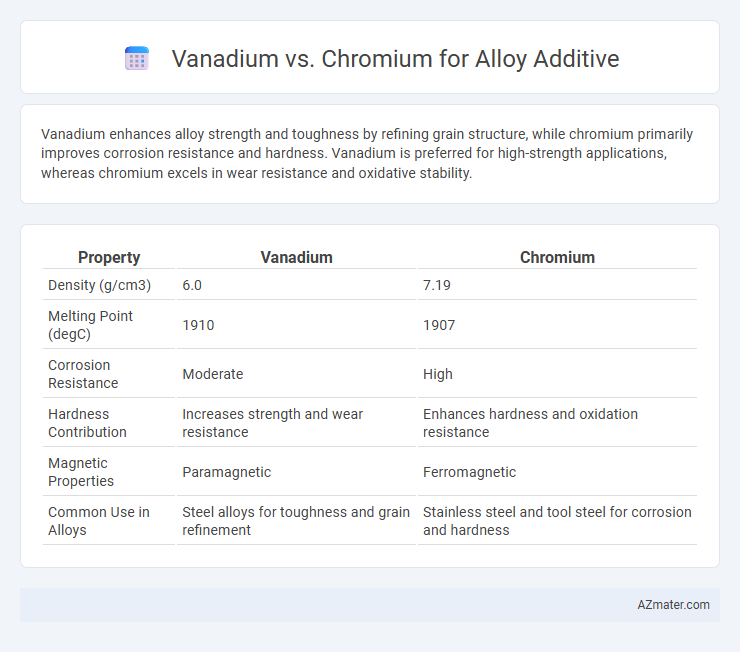Vanadium enhances alloy strength and toughness by refining grain structure, while chromium primarily improves corrosion resistance and hardness. Vanadium is preferred for high-strength applications, whereas chromium excels in wear resistance and oxidative stability.
Table of Comparison
| Property | Vanadium | Chromium |
|---|---|---|
| Density (g/cm3) | 6.0 | 7.19 |
| Melting Point (degC) | 1910 | 1907 |
| Corrosion Resistance | Moderate | High |
| Hardness Contribution | Increases strength and wear resistance | Enhances hardness and oxidation resistance |
| Magnetic Properties | Paramagnetic | Ferromagnetic |
| Common Use in Alloys | Steel alloys for toughness and grain refinement | Stainless steel and tool steel for corrosion and hardness |
Introduction to Alloy Additives
Vanadium and chromium are essential alloy additives that enhance the mechanical properties and corrosion resistance of steel. Vanadium increases strength and toughness by refining grain size and improving wear resistance, especially in high-strength low-alloy steels. Chromium primarily contributes to hardness and corrosion resistance, key for stainless steel production and improved oxidation resistance in industrial applications.
Overview of Vanadium and Chromium
Vanadium is a critical alloy additive known for significantly improving steel's strength, hardness, and wear resistance, especially in high-strength low-alloy (HSLA) steels. Chromium enhances corrosion resistance and toughness while increasing steel's hardness and oxidation resistance, essential in stainless steel and tool steel applications. Both elements play vital roles in alloy design, with vanadium primarily contributing to finer grain structure and chromium providing superior surface durability.
Chemical Properties and Reactivity
Vanadium exhibits high resistance to oxidation and forms stable carbides, enhancing alloy strength and durability at elevated temperatures. Chromium provides excellent corrosion resistance due to the formation of a passive oxide layer and contributes to hardness and wear resistance in steel alloys. Both elements improve alloy performance, but vanadium's chemical stability in reactive environments makes it ideal for high-strength, heat-resistant applications, while chromium excels in corrosion protection and surface hardness.
Effects on Mechanical Strength
Vanadium significantly enhances mechanical strength in alloys by refining grain size and promoting precipitation hardening, resulting in increased tensile strength and toughness. Chromium contributes to strength improvements primarily through solid solution strengthening and improved corrosion resistance, which indirectly supports durability under mechanical stress. When combined, vanadium and chromium synergistically improve the alloy's hardness, wear resistance, and fatigue performance, optimizing overall mechanical properties for demanding applications.
Influence on Corrosion Resistance
Vanadium enhances corrosion resistance in alloys by forming stable oxide layers that protect against environmental degradation, especially in stainless steels and high-strength alloys. Chromium significantly improves corrosion resistance by increasing the formation of a passive chromium oxide film, which acts as a barrier against oxidation and chemical attack. Alloys with higher chromium content generally exhibit superior resistance to rust and pitting corrosion compared to those relying primarily on vanadium.
Impact on Alloy Hardness and Toughness
Vanadium significantly enhances alloy hardness by promoting fine carbide precipitation, which refines grain structure and improves wear resistance. Chromium contributes to toughness through the formation of a stable passive oxide layer, increasing corrosion resistance and maintaining ductility. The combined addition of vanadium and chromium balances hardness and toughness, optimizing alloy performance in demanding applications.
Cost and Availability Comparison
Vanadium and chromium are critical alloy additives with distinct cost and availability profiles influencing their industrial use. Vanadium, typically more expensive due to limited global reserves and complex extraction processes, is valued for enhancing strength and wear resistance in steel alloys. In contrast, chromium benefits from higher abundance and more established supply chains, making it a cost-effective option for corrosion resistance and hardness in alloy applications.
Common Industrial Applications
Vanadium is widely used in steel alloys to improve strength, toughness, and corrosion resistance, making it essential for automotive parts, construction materials, and aerospace components. Chromium enhances hardness, wear resistance, and oxidation resistance, which is critical in stainless steel production and cutting tools manufacturing. Both elements serve key roles in alloy additives but are chosen based on specific industrial requirements such as durability, temperature resistance, and machinability.
Environmental and Health Considerations
Vanadium and chromium, commonly used as alloy additives, present different environmental and health considerations due to their distinct chemical properties. Vanadium exposure primarily risks respiratory issues and toxicity at high concentrations, yet it generally exhibits lower carcinogenic potential compared to chromium, especially hexavalent chromium (Cr(VI)), which is highly toxic and recognized as a carcinogen. The environmental impact of chromium wastes requires stringent handling and disposal protocols to mitigate soil and water contamination, whereas vanadium's environmental persistence is typically lower, making it a comparatively safer choice for sustainable alloy production.
Choosing Between Vanadium and Chromium
Choosing between vanadium and chromium as alloy additives depends on the desired material properties; vanadium enhances strength, toughness, and wear resistance, making it ideal for high-performance steels, while chromium provides excellent corrosion resistance and hardness, especially in stainless steel applications. Vanadium promotes grain refinement and improves fatigue resistance in alloy steels, whereas chromium's carbide formation boosts hardness and oxidation resistance at elevated temperatures. Consider vanadium for construction and tool steels requiring durability, and chromium for applications demanding rust prevention and surface hardness.

Infographic: Vanadium vs Chromium for Alloy Additive
 azmater.com
azmater.com